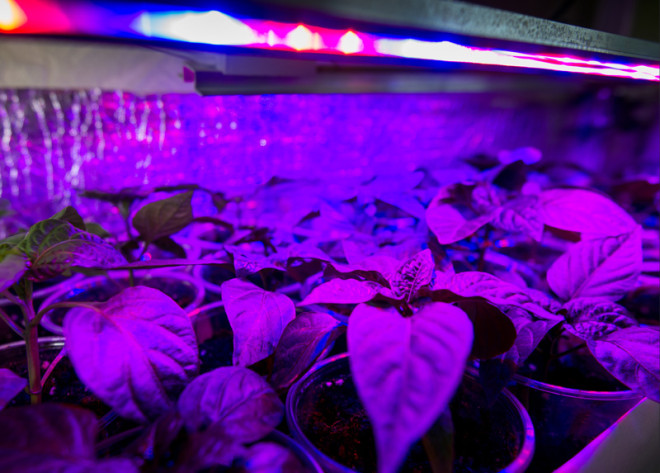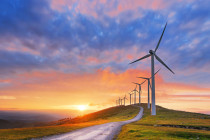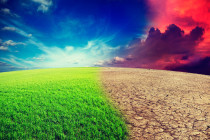Food. It’s a topic best served hot (or cold). Morsels of information regarding our sustenance find their way into almost every aspect of our lives. Whether it’s a new diet book touting the benefits of an all-organic, raw, vegan diet, or an article on the pros and cons of fish farming, food is all around us—we can’t escape it. The lighting industry is no exception. We’ve even posted about food on this blog before. Remember our tips for environmentally friendly veggie gardens and eco-friendly grocery shopping? If you scroll through our page, you’ll find even more articles pertaining to food. That’s because food, in particular the production of food, is always growing (witty, hey?). Farming is one of the oldest, if not the oldest, professions in the world, and, of course, it didn’t take long for it to be turned into a full-fledged industry. The business of agriculture is always changing. Whether it’s being impacted by the weather or by a new and improved tool on the market, there’s always something to report. At Mission, recent reports have been even more exciting than usual since they involve the newest agriculture trend of “plant-factories” and, you guessed it, LED lighting.
Greenhouses have been around for centuries to assist in compensating for less than stellar growing conditions. Developments in lighting led to the creation of semi-closed facilities, or high-tech greenhouses, where plants can be exposed to both sunlight and artificial light. Now, LED lighting is playing a key role in the development of fully closed facilities that use only artificial lighting to grow crops on multi-layer trays. These plant factories use controlled environment agriculture (CEA) to manage the vital elements needed for plants to grow: humidity, lighting, nutrients, temperature and water. The LEDs imitate the cycle of night and day, providing the wavelengths needed for photosynthesis.
While NASA may have been one of the pioneers in research and development of growing food indoors to provide food for space missions or countries with meager sunlight, Taiwan’s new generation of farmers are leveraging their countries’ command of LED technology to grow vegetables indoors. Five years ago, a customer told Solidlite chairmen Chen Hsing how favorable their LED lights were to plant growth, which led the Taiwanese company to focus on LED based plant factory systems and the development of high-efficiency LED agricultural lighting systems now sold in 17 countries. In the past, lighting systems using blue and red LEDs were produced to lower costs while still facilitating the process of photosynthesis. New research has enabled Taiwanese manufacturers to develop cheaper LEDs that are more energy efficient and simulate the light spectrum of the sun. Solidlite claims their testing shows the company’s patented wide-band LEDs (complete spectrum LEds) increase growth rates by up to 30 percent compared to red and blue LEDs, and induce photo morphogenesis (light-mediated development) in addition to photosynthesis.
The potential benefits of plant factories are hard to ignore. The space saving design of plant factories means they are perfect for cities, which means there could be a whole new batch of farmers to help fill the void being created by an aging population. It has also been suggested that younger generations are more open to working in plant factories since most are located in or near the city, they involve less physical labour, and they provide a clean and comfortable working environment. As for the actual agricultural benefits, the results are pretty impressive. So far, CEA farms report higher yields than soil, growth rates two times as outdoor farming, lower water consumption, and lower labour and space requirements. This is in addition to addressing many of the challenges of conventional farming such as unpredictable weather conditions, pollution, land shortages, and water access. By 2050, there will be an additional 2.5 billion people living in cities to feed. Even if plant factories don’t replace traditional farming methods, they could assist with the production of high-value crops while creating employment.
It’s easy to see why plant factories are growing in popularity, with operations popping up everywhere from Portage, Ind. (Green Sense Farms) to sector leading countries like Japan and the Netherlands. There are, however, still a few bugs to be worked out. The cost to build a plant factory is extremely high, as is maintaining operations due to the electricity requirements to power systems to control humidity, light, nutrients, and water. This, of course, typically impacts the cost of the produce. The current challenge for LED manufacturers is to increase energy efficiency to reduce factory production costs.
As research continues into how to adjust LED wavelengths to maximize quality and enhance plant growth, we are looking forward to bringing you more on the role LEDs will have on your food choices. It might not be long before you can buy customized produce—sweet or sour, hard or soft … your strawberry selection might just get a little bigger.
About The Author

-
Serial Entrepreneur, Technologist and Inventor.
My objective is to develop useful products that have a net positive effect in the lives of those that use them and the environment that we live in.
CEO of Mission LED Lighting Company Ltd.
- 2017.05.24LED factsWhy Are Cars Switching to LEDs if They’re Too Bright?
- 2017.05.09Be green & saveHow to Easily Replace T8 Fluorescent Tubes With LED
- 2017.03.07Build a better future7 Things About Explosion Proof LED Lighting You Should Know
- 2017.02.28Be green & saveWhy We Love LED Grow Lights (And You Should, Too!)





Leave a Reply